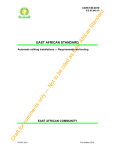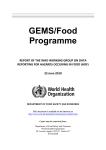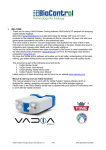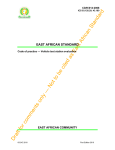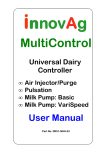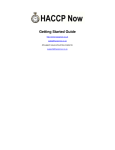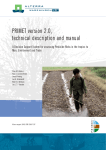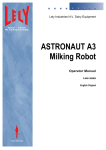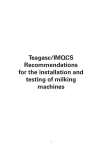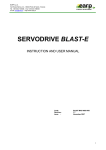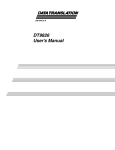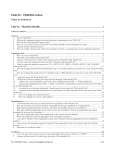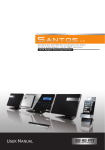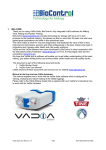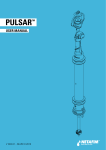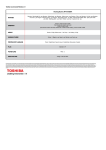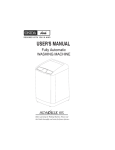Download CD-K-745-2010, Milking machine installations Š
Transcript
CD/K/745:2010 fric an St an da rd ICS 67.120 tA EAST AFRICAN STANDARD EAST AFRICAN COMMUNITY Dr aft for co mm en ts o nly -N ot to b ec ite da sE as Milking machine installations — Mechanical tests © EAC 2010 First Edition 2010 rd CD/K/745:2010 da Foreword St an Development of the East African Standards has been necessitated by the need for harmonizing requirements governing quality of products and services in East Africa. It is envisaged that through harmonized standardization, trade barriers which are encountered when goods and services are exchanged within the Community will be removed. tA fric an In order to meet the above objectives, the EAC Partner States have enacted an East African Standardization, Quality Assurance, Metrology and Test Act, 2006 (EAC SQMT Act, 2006) to make provisions for ensuring standardization, quality assurance, metrology and testing of products produced or originating in a third country and traded in the Community in order to facilitate industrial development and trade as well as helping to protect the health and safety of society and the environment in the Community. ite da sE as East African Standards are formulated in accordance with the procedures established by the East African Standards Committee. The East African Standards Committee is established under the provisions of Article 4 of the EAC SQMT Act, 2006. The Committee is composed of representatives of the National Standards Bodies in Partner States, together with the representatives from the private sectors and consumer organizations. Draft East African Standards are circulated to stakeholders through the National Standards Bodies in the Partner States. The comments received are discussed and incorporated before finalization of standards, in accordance with the procedures of the Community. to b ec Article 15(1) of the EAC SQMT Act, 2006 provides that “Within six months of the declaration of an East African Standard, the Partner States shall adopt, without deviation from the approved text of the standard, the East African Standard as a national standard and withdraw any existing national standard with similar scope and purpose”. -N ot East African Standards are subject to review, to keep pace with technological advances. Users of the East African Standards are therefore expected to ensure that they always have the latest versions of the standards they are implementing. * © East African Community 2010 — All rights reserved nly East African Community P O Box 1096 ts o Arusha Tanzania en Tel: 255 27 2504253/8 Fax: 255-27-2504481/2504255 mm E-Mail: [email protected] Dr aft for co Web: www.each.int * ii 2010 EAC — All rights of exploitation in any form and by any means reserved worldwide for EAC Partner States’ NSBs. © EAC 2010 — All rights reserved CD/K/745:2010 rd Introduction da In the preparation of this East African Standard, the following sources were consulted extensively: St an ISO 6690:2007, Milking machine installations — Mechanical tests Codex Alimentarius website: http://www.codexalimentarius.net/mrls/pestdes/jsp/pest_q-e.jsp an USDA Foreign Agricultural Service website: http://www.mrldatabase.com fric USDA Agricultural Marketing Service website: http://www.ams.usda.gov/AMSv1.0/Standards tA USDA Plant Inspectorate Service website: http://www.aphis.usda.gov/import_export/plants Dr aft for co mm en ts o nly -N ot to b ec ite da sE Assistance derived from these sources is hereby acknowledged. as European Union: http://ec.europa.eu/sanco_pesticides/public © EAC 2010 — All rights reserved iii ISO 6690 Third edition 2007-02-15 tA fric an St an da rd INTERNATIONAL STANDARD sE as Milking machine installations — Mechanical tests Dr aft for co mm en ts o nly -N ot to b ec ite da Installations de traite mécanique — Essais mécaniques Reference number ISO 6690:2007(E) © ISO 2007 ISO 6690:2007(E) rd PDF disclaimer St an da This PDF file may contain embedded typefaces. In accordance with Adobe's licensing policy, this file may be printed or viewed but shall not be edited unless the typefaces which are embedded are licensed to and installed on the computer performing the editing. In downloading this file, parties accept therein the responsibility of not infringing Adobe's licensing policy. The ISO Central Secretariat accepts no liability in this area. Adobe is a trademark of Adobe Systems Incorporated. © ISO 2007 co mm en ts o nly -N ot to b ec ite da sE as tA fric an Details of the software products used to create this PDF file can be found in the General Info relative to the file; the PDF-creation parameters were optimized for printing. Every care has been taken to ensure that the file is suitable for use by ISO member bodies. In the unlikely event that a problem relating to it is found, please inform the Central Secretariat at the address given below. for All rights reserved. Unless otherwise specified, no part of this publication may be reproduced or utilized in any form or by any means, electronic or mechanical, including photocopying and microfilm, without permission in writing from either ISO at the address below or ISO's member body in the country of the requester. Dr aft ISO copyright office Case postale 56 • CH-1211 Geneva 20 Tel. + 41 22 749 01 11 Fax + 41 22 749 09 47 E-mail [email protected] Web www.iso.org Published in Switzerland ii © ISO 2007 – All rights reserved da rd ISO 6690:2007(E) St an Contents Page Foreword............................................................................................................................................................. v Scope ..................................................................................................................................................... 1 2 Normative references ........................................................................................................................... 1 3 Definitions ............................................................................................................................................. 1 4 4.1 4.2 4.3 4.4 4.5 4.6 4.7 4.8 4.9 Test equipment ..................................................................................................................................... 1 General................................................................................................................................................... 1 Measurement of vacuum...................................................................................................................... 2 Measurement of a vacuum changing over time ................................................................................ 2 Measurement of atmospheric pressure.............................................................................................. 2 Measurement of back pressure........................................................................................................... 2 Measurement of airflow........................................................................................................................ 3 Measurement of pulsation characteristics......................................................................................... 3 Measurement of pump rotational frequency...................................................................................... 3 Teatcup plugs........................................................................................................................................ 3 5 5.1 5.2 5.3 5.4 5.5 5.6 5.7 5.8 5.9 5.10 Vacuum system..................................................................................................................................... 4 General requirements and preparation .............................................................................................. 4 Vacuum regulation................................................................................................................................ 5 Vacuum pumps ..................................................................................................................................... 8 Vacuum regulator leakage ................................................................................................................. 10 Vacuum gauge error ........................................................................................................................... 11 Vacuum drop in air line ...................................................................................................................... 11 Effective volume of interceptor ......................................................................................................... 11 Effective volume of the sanitary trap................................................................................................ 12 Leakage in vacuum system ............................................................................................................... 12 Vacuum drop across vacuum taps for bucket milking units ......................................................... 12 6 6.1 6.2 Pulsation system ................................................................................................................................ 13 Airflow at stall taps ............................................................................................................................. 13 Pulsation rate, pulsator ratio, pulsation chamber vacuum phases and vacuum drop in pulsator air line ................................................................................................................................... 13 7 7.1 7.2 7.3 7.4 Milk system.......................................................................................................................................... 14 Slope of milkline ................................................................................................................................. 14 Milk system leakage ........................................................................................................................... 14 Effective volume of receiver .............................................................................................................. 14 Leakage in releaser............................................................................................................................. 15 8 8.1 8.2 8.3 8.4 8.5 8.6 8.7 8.8 Milking unit .......................................................................................................................................... 15 Mouthpiece depth and effective length of liner ............................................................................... 15 Teatcup or cluster fall-off air inlet..................................................................................................... 17 Leakage through shut-off valves of milking units........................................................................... 17 Air vent and leakage into teatcup or cluster .................................................................................... 17 Effective volume of buckets, transport cans and recorder jars .................................................... 17 Measuring the vacuum in the cluster ............................................................................................... 18 Measurement of the vacuum drop from accessories attached in the long milk tube ................. 18 Airflow at the end of the long milk tube ........................................................................................... 18 Dr aft for co mm en ts o nly -N ot to b ec ite da sE as tA fric an 1 Annex A (normative) Laboratory tests of vacuum in the milking unit........................................................ 20 Annex B (informative) Alternative method for the measurement of air inlet and leakages in clusters ................................................................................................................................................ 25 Annex C (informative) Examples of test procedure to reduce the test work ............................................. 27 © ISO 2007 – All rights reserved iii ISO 6690:2007(E) Dr aft for co mm en ts o nly -N ot to b ec ite da sE as tA fric an St an da rd Annex D (informative) Test report for testing milking machine installations in accordance with ISO 6690 ....................................................................................................................................... 32 iv © ISO 2007 – All rights reserved da rd ISO 6690:2007(E) St an Foreword fric an ISO (the International Organization for Standardization) is a worldwide federation of national standards bodies (ISO member bodies). The work of preparing International Standards is normally carried out through ISO technical committees. Each member body interested in a subject for which a technical committee has been established has the right to be represented on that committee. International organizations, governmental and non-governmental, in liaison with ISO, also take part in the work. ISO collaborates closely with the International Electrotechnical Commission (IEC) on all matters of electrotechnical standardization. tA International Standards are drafted in accordance with the rules given in the ISO/IEC Directives, Part 2. sE as The main task of technical committees is to prepare International Standards. Draft International Standards adopted by the technical committees are circulated to the member bodies for voting. Publication as an International Standard requires approval by at least 75 % of the member bodies casting a vote. ite da Attention is drawn to the possibility that some of the elements of this document may be the subject of patent rights. ISO shall not be held responsible for identifying any or all such patent rights. ISO 6690 was prepared by Technical Committee ISO/TC 23, Tractors and machinery for agriculture and forestry. Dr aft for co mm en ts o nly -N ot to b ec This third edition cancels and replaces the second edition (ISO 6690:1996) which has been technically revised. © ISO 2007 – All rights reserved v Dr aft for nly ts o en mm co ot -N ec to b ite da tA as sE an fric rd da St an ISO 6690:2007(E) St an Milking machine installations — Mechanical tests da rd INTERNATIONAL STANDARD Scope as 1 tA fric an WARNING — Some of the tests specified in this International Standard involve procedures which could lead to a hazardous situation. The attention of any person performing tests in accordance with this International Standard is drawn to the need to be appropriately trained in the type of work to be carried out. It is left to the responsibility of the user to check all national regulatory conditions and health and safety requirements applicable for the relevant country. ite da sE This International Standard specifies mechanical tests for milking machine installations in order to verify compliance of an installation or component with the requirements of ISO 5707. It also stipulates the accuracy requirements for the measuring instruments. ec This International Standard is applicable for testing new installations and for periodic checking of installations for efficiency of operation. Alternative test methods may be applicable if they can be shown to achieve comparable results. Normative references ot 2 to b Test procedures described in Annex A are primarily for testing in the laboratory. An example of a field test procedure which can reduce the time and effort involved in testing is given in Annex C and a corresponding test report in Annex D. nly -N The following referenced documents are indispensable for the application of this document. For dated references, only the edition cited applies. For undated references, the latest edition of the referenced document (including any amendments) applies. ISO 3918:2007, Milking machine installations — Vocabulary Definitions en 3 ts o ISO 5707:2007, Milking machine installations — Construction and performance mm For the purposes of this document, the terms and definitions given in ISO 3918 apply. Test equipment General for 4.1 co 4 Dr aft Measurements to be made for the specific milking machine shall be determined before making the tests. The measuring equipment shall have a precision (maximum error) that, together with the skill of the tester, ensures that the requirements given in ISO 5707 can be recorded with sufficient accuracy. The instruments shall be calibrated regularly to ensure the given specifications. © ISO 2007 – All rights reserved 1 ISO 6690:2007(E) Measurement of vacuum St an 4.2 da rd The measuring points A1, A2, Vm, Vr, Vp and Pe referred to in this International Standard are described in 4.2.2 and 4.2.3 of ISO 5707:2007. The instrument used for measuring vacuum shall be able to measure with an error of less than ± 0,6 kPa and a repeatability within ± 0,2 kPa. Measurement of a vacuum changing over time tA 4.3 fric an NOTE A vacuum gauge of accuracy class 1,0 will usually meet this requirement if calibrated at a vacuum close to that measured. The accuracy class is defined as the maximum permissible error expressed as a percentage of the pressure range for the gauge. sE as The instrument used for measuring a vacuum changing over time shall fulfil the minimum requirements given in Table 1. If the sample rate is much higher than the minimum given in Table 1, then filtering shall be applied. The filtering frequency shall be maximum 50 % of the measuring frequency and approximately the frequency of the expected signal intended to be captured. ite da NOTE The minimum requirements given in Table 1 ensure that 90 % of the true amplitude and rate of vacuum changes, or 90 % of the resolution of the recording equipment (0,2 kPa), will be measured, whichever is greater. No. of test to b Type of test ec Table 1 — Minimum sample rate and response rates for vacuum recording systems Minimum sample rate Minimum response rate Hz kPa/s Tests in the receiver and in dry parts of the milking machine. 24 100 2 Test of pulsators 100 1 000 3 Wet or milking-time tests in the milkline. 48 1 000 4 Wet or milking-time tests in the claw. 63 1 000 5 Wet or milking-time tests in the short milk tube. 170 2 500 6 Milking-time test of vacuum changes in the short milk tubes during a liner slip. 1 000 22 000 7 Milking-time test of vacuum changes in the short milk tubes during a liner squawk. 2 500 42 000 ts o nly -N ot 1 4.4 mm en NOTE Normal rate of vacuum change in the pulsation chamber in the beginning of phases a and c (see ISO 3918:2006, 5.9 and 5.11) can be about 1 000 kPa/s. Measurement of atmospheric pressure co The instrument used for measuring the atmospheric pressure shall be able to measure with an error of less than ± 1 kPa. Measurement of back pressure for 4.5 Dr aft The instrument used for measuring back pressure shall be able to measure with an error of less than ± 1 kPa. 2 © ISO 2007 – All rights reserved ISO 6690:2007(E) Measurement of airflow rd 4.6 Correction curves shall be supplied if they are necessary to achieve this accuracy. St an da The instrument used for measuring airflow shall be capable of measuring with a maximum error of 5 % of the measured value and a repeatability of 1 % of the measured value or 1 I/min of free air, whichever is the greater, over a vacuum range of 30 kPa to 60 kPa and for atmospheric pressures from 80 kPa to 105 kPa. an NOTE 1 A fixed orifice flowmeter is suitable for airflows admitted from the atmosphere. Such a meter is an adjustable calibrated valve that allows a set airflow to enter a vacuum system. tA fric NOTE 2 To measure the air admission and leakage in a cluster or teatcup (see 8.3 and 8.4) a flowmeter actually measuring the passing airflow is necessary. A variable area flowmeter is suitable. When inserted in the long milk tube they measure expanded airflow and thus must be calibrated or corrected to the available vacuum or air pressure. as As flowmeters actually measure the flow at the operating vacuum, most meter readings shall be corrected for that vacuum and the ambient atmospheric pressure according to the instructions for the instrument. Measurement of pulsation characteristics ite da 4.7 sE An alternative method for measuring air admission and leakage without a flowmeter is given in Annex B. ec The instrument, including connection tubes, used for measuring pulsation characteristics shall measure with an error of less than ± 1 pulse/min for the pulsation rate and with an error of less than ± 1 unit of percentage for the pulsation phases and the pulsator ratio (see Figure 6 of ISO 3918:2007). See also Table 1. 4.8 to b The dimensions of the connection tube and T-piece used for attachment to the installation shall be specified with the instrument. Measurement of pump rotational frequency 4.9 -N ot The instrument used for measuring the rotational frequency of the pump shall be able to measure with an error of less than 2 % of the measured value. Teatcup plugs nly Standard teatcup plugs which are in accordance with Figure 1 shall be used. Dr aft for co mm en ts o The plugs shall withstand cleaning and disinfection. The materials shall comply with the requirements given in 4.4 of ISO 5707:2007 for materials in contact with milk. Some means shall be provided to keep the plug in the liner (e.g. a bead or a cylindrical part). © ISO 2007 – All rights reserved 3 ISO 6690:2007(E) rd Dimensions in millimetres ite da sE as tA fric an St an da General tolerance ± 1 mm The design adopted for this part shall permit complete penetration into the liner. b Length of protrusion into the liner (9 mm + 30 mm + 20 mm = 59 mm). to b ec a 5.1 5.1.1 -N Vacuum system General requirements and preparation nly 5 ot Figure 1 — Teatcup plug General en ts o 5.1.1.1 To keep a milking plant in good condition, periodic checking is recommended. If the effective reserve (see 5.2.5) obtained at the acceptance test has not changed significantly, it is not necessary to perform the tests described in 5.2.4, 5.3.1 and 5.4. Preparation before testing co 5.1.2 mm 5.1.1.2 For the investigation of particular defects or failures, only those tests that are appropriate to the problem need to be applied. Dr aft for 5.1.2.1 Start the vacuum pump and put the milking machine into the milking position with all milking units connected. Portable milking units shall be placed at the most distant milking positions. Teatcup plugs conforming to 4.9 shall be fitted and all controls (e.g. automatic cluster remover systems) shall be in the milking position. All vacuum-operated equipment associated with the installation shall be connected including those not operating during milking. NOTE It should be observed that, for the measurements specified in 5.6 and 6.2, the place of the units on the milkline can influence the results significantly. 5.1.2.2 Unless otherwise specified in the user's manual, allow the vacuum pump to run for at least 15 min before taking any measurements. 4 © ISO 2007 – All rights reserved ISO 6690:2007(E) 5.2.1 da Vacuum regulation St an 5.2 Record the atmospheric pressure. rd 5.1.2.3 Test of vacuum regulation deviation See 5.2.1 of ISO 5707:2006. Regulation sensitivity tA 5.2.2 fric an With the milking machine running in accordance with 5.1.2, record the working vacuum at the receiver and compare it with the nominal vacuum. See 5.2.2 of ISO 5707:2007. sE as 5.2.2.1 With the milking machine operating in accordance with 5.1.2, connect a vacuum meter to the connection point Vm. 5.2.2.2 Record the vacuum as the working vacuum for the milking machine. ite da 5.2.2.3 Shut off all milking units and record the vacuum. The milking machine shall then be in the same state as during milking but with no milking unit in operation. Regulation loss to b 5.2.3 ec 5.2.2.4 Calculate the regulation sensitivity as the difference between the vacuum measured with no milking units in operation (see 5.2.2.3) and that with all units operating (see 5.2.2.2). See 5.2.3 of ISO 5707:2007 and 5.1.1.1 of this document. This test is not applicable to bucket and direct-to-can milking machines. ot NOTE -N 5.2.3.1 With the milking machine operating in accordance with 5.1.2, connect the airflow meter with a full-bore connection to connection point A1 (see Figures 2 and 3 of ISO 3918:2007), with the airflow meter closed. Connect a vacuum meter to the connection point Vm. Record the vacuum as the working vacuum for the milking machine. nly 5.2.3.2 en ts o 5.2.3.3 Open the airflow meter until the vacuum decreases by 2 kPa from the value measured in 5.2.3.2.and record the airflow. For systems with capacity controlled pumps only, check that the pump is running at its maximum speed. If so, there is no regulation loss. mm NOTE With multiple receivers it may be necessary to divide the air admission appropriately between connection points A1. co 5.2.3.4 Stop any airflow through regulators that admit air and set capacity controlled pumps to their maximum capacity. for 5.2.3.5 Decrease the vacuum by opening the airflow meter to the same as in 5.2.3.3 and record the airflow as the manual reserve for the milking machine. Dr aft 5.2.3.6 Calculate the regulation loss as the difference between the airflows recorded in 5.2.3.5 and 5.2.3.3. 5.2.4 Tests of regulation characteristics See 5.2.4 of ISO 5707:2007. © ISO 2007 – All rights reserved 5 ISO 6690:2007(E) 1) use one cluster with shut-off valve enabled (fall-off test); 2) use one teatcup, with the shut-off valve in attachment position (attachment test). 1) use one cluster (fall-off test); 2) use one teatcup (attachment test). tA fric b) Milking unit without automatic shut-off valve: as Quarter milking: use one teatcup (fall-off test); 2) use one teatcup with the shut-off valve in attachment position (attachment test). sE 1) to b ec ite da c) St an Milking unit with automatic shut-off valve: an a) da rd 5.2.4.1 The regulation characteristics are preferably tested in the fall-off and attachment tests. The presence or absence of an automatic shut-off valve as well as quarter milking will affect the way the tests are carried out. The tests shall therefore be performed as follows. ot Key undershoot 1 phase 1: no teatcup open B vacuum drop 2 phase 2: teatcup(s) are open C overshoot -N A phase 3: teatcup(s) open phase 4: teatcup(s) are closed nly 3 4 en ts o Figure 2 — Regulation undershoot, vacuum drop and regulation overshoot for rapid changes in air admission 5.2.4.3 mm 5.2.4.2 With the milking machine operating in accordance with 5.1.2, connect a vacuum recorder to measuring point Vm. Record the vacuum for 5 s to 15 s: phase 1 of Figure 2. for co 5.2.4.4 While recording, open one teatcup or one cluster and record for 5 s to 15 s after the vacuum has stabilized: phases 2 and 3 of Figure 2. If 32 or more clusters or teatcups for quarter milking are connected, open one cluster or teatcup per every 32 clusters or teatcups. Dr aft If the milking unit is equipped with an automatic shut-off valve, this shall be in operation for the fall-off test, and in or out of operation as during attachment, for the attachment test. 5.2.4.5 While recording, close the teatcup or cluster and record for 5 s to 15 s after the vacuum has stabilized: phase 4 of Figure 2. 5.2.4.6 6 Calculate the average vacuum during 5 s of phase 1. © ISO 2007 – All rights reserved 5.2.4.8 Calculate the average vacuum during 5 s of the stable part of phase 3. 5.2.4.9 Find the maximum vacuum of phase 4. 5.2.4.10 Calculate the average vacuum during 5 s of the stable part of phase 4. da Find the minimum vacuum of phase 2. St an 5.2.4.7 rd ISO 6690:2007(E) an 5.2.4.11 Calculate the fall-off vacuum drop or the attachment vacuum drop (B in Figure 2) as the average vacuum in 5.2.4.6 (phase 1) minus the average vacuum in 5.2.4.8 (phase 3). tA fric 5.2.4.12 Calculate the regulation undershoot (A in Figure 2) as the average in 5.2.4.8 (phase 3) minus the minimum vacuum in 5.2.4.7 (phase 2). Effective reserve for milking ite da See 5.2.4 of ISO 5707:2007 and 5.1.1.1 of this document. sE 5.2.5 as 5.2.4.13 Calculate the regulation overshoot (C in Figure 2) as the maximum vacuum in 5.2.4.9 (phase 4) minus the average vacuum in 5.2.4.10 (phase 4). 5.2.5.1 With the milking machine operating in accordance with 5.1.2, connect the airflow meter with a fullbore connection to connection point A1 (see Figures 1, 2 and 3 of ISO 3918:2007), with the airflow meter closed. Connect a vacuum meter to the connection point Vm. Record the vacuum as the working vacuum for the milking machine. 5.2.5.3 Open the airflow meter until the vacuum decreases by 2 kPa from the value measured in 5.2.5.2. to b ec 5.2.5.2 NOTE With multiple receivers it may be necessary to divide the air admission appropriately between connection points A1. Record the airflow through the airflow meter. -N ot 5.2.5.4 nly If the ambient atmospheric pressure at the time of the test differs by more than 3 kPa from the standard atmospheric pressure for the altitude (see Table 3), the corrected airflow shall be calculated from the measured value by the method given in 5.2.6. Calculation of effective reserve capacity at standard atmospheric pressure en 5.2.6 ts o 5.2.5.5 The airflow recorded in 5.2.5.4 shall be reduced by the air consumption of equipment normally operating during milking but not operating during the test (e.g. diaphragm milk pumps operated by float switch). The resulting airflow is the effective reserve. mm The predicted effective reserve, qR,th, at standard atmospheric pressure can be calculated for positive displacement vacuum pumps by: co qR,th = K 2 × q − p s + pa × ( q − qR,m ) 2 × ps (1) for where is a factor calculated in accordance with 5.3.2.2 or the values given in Table 4; q is the measured pump capacity, in litres per minute of free air (l/min), at the prevailing atmospheric pressure; Dr aft K2 © ISO 2007 – All rights reserved 7 ISO 6690:2007(E) is the measured effective reserve, in litres per minute of free air (l/min), at the prevailing atmospheric pressure; pa is the prevailing atmospheric pressure during the test, in kilopascals (kPa); ps is the standard atmospheric pressure, in kilopascals (kPa). 5.3.1 da St an an Vacuum pumps Vacuum pump capacity fric 5.3 rd qR,m See 5.3.1 of ISO 5707:2007 and 5.1.1.1 of this document. as tA 5.3.1.1 With the milking machine operating in accordance with 5.1.2, record the vacuum at the vacuum pump measuring connection Vp as the working vacuum for the pump. sE 5.3.1.2 Isolate the vacuum pump from all other parts of the installation and, for capacity controlled pumps, ensure that they are running at maximum capacity. Connect the airflow meter directly to the vacuum pump with a full-bore connection. ite da 5.3.1.3 Record the airflow meter reading at the same vacuum as recorded in 5.3.1.1 as the pump capacity at the working vacuum. to b ec To compare the measured vacuum pump capacity with previous values when the atmospheric pressure at the time of the test differs by more than 3 kPa from the standard atmospheric pressure for the altitude (see Table 3), the airflow at that altitude should be corrected by the factor K2, calculated in accordance with 5.3.2.2 or the values given in Table 4. To calculate this correction, the maximum vacuum of the pump is needed (see 5.3.1.7). Record the airflow meter reading, q50, in litres per minute, at a vacuum of 50 kPa. 5.3.1.5 Record the rotational frequency of the vacuum pump, n, per min at a vacuum of 50 kPa. ot 5.3.1.4 nom = n nom n ×q 50 (2) ts o q nly -N 5.3.1.6 Calculate the nominal vacuum pump capacity, qnom, in litres per minute for positive displacement vacuum pumps, from the formula: where nnom is the nominal rotational frequency of the vacuum pump per min. mm en To compare the measured vacuum pump capacity with the nominal values marked on the pump when the ambient atmospheric pressure differs by more than 3 kPa from the reference atmospheric pressure of 100 kPa, the flow should be corrected by the factor K1 calculated in accordance with 5.3.2.1 or the values given in Table 2. To calculate this correction, the maximum vacuum of the pump is needed (see 5.3.1.7). for co 5.3.1.7 Close the airflow meter totally until the vacuum has stabilized unless the manufacturer has specified an alternative test method. Record the maximum vacuum, pmax, and open the airflow meter again to avoid pump damage. Dr aft This measurement needs only to be made if the pump capacity has to be corrected by calculation. The result is only relevant if the rotational frequency does not decrease by more than 1 %. 8 © ISO 2007 – All rights reserved ISO 6690:2007(E) Calculations for other atmospheric pressures rd 5.3.2 5.3.2.1 St an da Vacuum pump capacity (and measured effective reserve) for a milking machine varies with ambient atmospheric pressure. When a milking machine is tested, the measured values shall be multiplied by correction factors, which give predicted values under standard atmospheric pressure or nominal conditions. Calculation of vacuum pump capacity under nominal conditions max K1 = −p nom × p a p an tA p fric an The vacuum pump capacity of positive displacement vacuum pumps at the nominal atmospheric pressure of 100 kPa is obtained by multiplying the measured capacity by the factor K1 calculated from the formula: (3) as p max − p sE where is the ambient atmospheric pressure during the test, in kilopascals (kPa); pan is the nominal atmospheric pressure, in kilopascals (kPa) (usually 100); ite da pa pmax is the maximum vacuum at the totally closed pump inlet during the test, in kilopascals (kPa); is the vacuum (calculated or actual) at the pump inlet, in kilopascals (kPa); p ec pnom is the nominal vacuum at the pump inlet, in kilopascals (kPa) (usually 50). to b The correction factor K1 to calculate the predicted vacuum pump capacity at the nominal atmospheric pressure of 100 kPa for volumetric efficiency, ηv = pmax/pa, of 90 % is given in Table 2. ot Table 2 — Correction factor K1 at different atmospheric pressures -N Ambient atmospheric pressure, Pa kPa 95 90 ts o 85 nly 100 1,00 1,07 1,16 1,28 1,45 en 80 Correction factor, K1, for a vacuum at a pump capacity of 50 kPa Calculation of vacuum pump capacity under standard atmospheric pressure mm 5.3.2.2 Table 3 — Standard atmospheric pressures at different altitudes Dr aft for co For the purposes of this International Standard, standard atmospheric pressures at different altitudes are given in Table 3. Altitude, h Standard atmospheric pressure, Ps m kPa h < 300 100 300 u h < 700 95 700 u h < 1 200 90 1 200 u h < 1 700 85 1 700 u h < 2 200 80 © ISO 2007 – All rights reserved 9 ISO 6690:2007(E) da rd The vacuum pump capacity of positive displacement vacuum pumps at the standard atmospheric pressure for the altitude, as given in Table 3, is obtained by multiplying the measured capacity by the factor K2 calculated from the formula: St an pa ps −p pmax − p K2 = pmax an where (4) is the ambient atmospheric pressure during the test, in kilopascals (kPa); ps is the standard atmospheric pressure for the altitude, in kilopascals (kPa); tA fric pa is the vacuum (calculated or actual) at the pump inlet, in kilopascals (kPa). sE p as pmax is the maximum vacuum at the totally closed pump inlet during the test, in kilopascals (kPa); ite da The correction factor K2 to calculate the predicted vacuum pump capacity at an atmospheric pressure of 100 kPa for some vacuum values based on a volumetric efficiency, ηv = pmax/pa, of 90 % is given in Table 4. Table 4 — Correction factor K2 for various atmospheric pressures Correction factor, K2, for a vacuum at a pump capacity of ec Ambient atmospheric pressure, Pa 40 KPa 45 KPa 50 KPa 109 0,94 0,92 0,91 0,96 0,95 0,93 0,98 0,97 0,96 1,00 1,00 1,00 1,03 1,03 1,04 1,05 1,07 1,09 1,09 1,11 1,14 to b kPa 106 103 ot 100 -N 97 94 Vacuum pump exhaust back pressure en See 5.3.6 of ISO 5707:2007. ts o 5.3.3 nly 91 5.4 mm With the vacuum pump operating in accordance with 5.3.1.1, measure and record the exhaust back pressure at the connection point Pe. Vacuum regulator leakage co See 5.4.1 of ISO 5707:2007 and 5.1.1.1 of this document. Dr aft for 5.4.1 With the milking machine operating in accordance with 5.1.2, connect the airflow meter with a full-bore connection to connection point A1 (see Figures 1, 2 and 3 of ISO 3918:2007), with no airflow through it. A vacuum meter shall be connected to connection point Vr. 5.4.2 Record the vacuum as the regulator working vacuum. 5.4.3 Decrease the vacuum by 2 kPa by opening the airflow meter and record the airflow. For systems with capacity controlled pumps only, check that the pump is running at its maximum speed. If so, there is no regulator leakage. 10 © ISO 2007 – All rights reserved ISO 6690:2007(E) da rd NOTE With multiple receivers it may be necessary to divide the air admission appropriately between connection points A1. 5.4.5 St an 5.4.4 Stop the airflow through regulators that admit air and set capacity controlled pumps to maximum capacity. Open the airflow meter and decrease the vacuum to the same as in 5.4.3 and record the airflow. Vacuum gauge error fric 5.5 an 5.4.6 Calculate the regulator leakage as the difference between the airflow recorded in 5.4.5 and that recorded in 5.4.3. tA See 5.5.1 of ISO 5707:2007. 5.6 Record the difference between these two values as the error of the gauge. ite da 5.5.2 sE as 5.5.1 With the milking machine and vacuum regulator operating, but with no milking unit operating, and the test vacuum meter connected to connection point Vr (see Figures 1, 2 and 3 of ISO 3918:2007) or another suitable connection point near the vacuum gauge, record the values on the vacuum gauge of the plant and the test vacuum meter. Vacuum drop in air line ec See 5.6.2 of ISO 5707:2007. NOTE This test is only applicable to recorder and pipeline milking machines. to b 5.6.1 With the milking machine operating in accordance with 5.1.2, connect the airflow meter with a full-bore connection to point A1 (see Figures 1, 2 and 3 of ISO 3918:2007), with no airflow through it. A vacuum meter shall be connected to point Vm. Record the vacuum as the working vacuum for the milking machine. Move the vacuum meter to regulator connection point Vr and record the working vacuum. nly 5.6.3 -N ot 5.6.2 Open the airflow meter until the vacuum at Vm decreases by 2 kPa from the value measured in 5.6.1 and record the working vacuum. 5.6.5 ts o 5.6.4 Calculate the vacuum drop between Vm and Vr as the difference between the vacuum recorded in 5.6.2, at Vm, and that recorded in 5.6.3, at Vr, in both cases with the same airflow. Move the vacuum meter to vacuum pump connection point Vp and record the working vacuum. 5.7 mm en 5.6.6 Calculate the vacuum drop between Vm and Vp as the difference between the vacuum recorded in 5.6.2, at Vm, and that recorded in 5.6.5, at Vp, in both cases with the same airflow. Effective volume of interceptor Set the milking machine to work in accordance with 5.1.2. for 5.7.1 co See 5.7 of ISO 5707:2007. Dr aft 5.7.2 Connect a tube to the vacuum tap closest to the interceptor and allow a water flow of about 5 I/min into the tube. Water will be sucked into the interceptor until the activation of the means to prevent liquid from entering the vacuum pump is activated. See 5.8.4. Care should be taken so that a harmful amount of water does not enter the vacuum pump. © ISO 2007 – All rights reserved 11 ISO 6690:2007(E) Effective volume of the sanitary trap St an 5.8 da rd 5.7.3 When the means to prevent liquid from entering the vacuum pump is activated, stop the vacuum pump and record the volume of water in the interceptor as the effective volume of the interceptor and state the vacuum pump capacity. Set the milking machine to work in accordance with 5.1.2. 5.8.2 Connect an airflow meter to the connection point A1. fric 5.8.1 an See 5.8 of ISO 5707:2007. tA 5.8.3 Allow an airflow corresponding to the effective reserve, and a water flow of about 5 I/min, to enter the receiver. as To be able to state this volume, type tests will usually be made. For such tests, also the maximum corresponding airflow should be measured. ite da sE 5.8.4 Fill the receiver and sanitary trap until the means to minimize liquid entry to the vacuum system is activated. 5.8.5 Close the vacuum supply to the milking system and collect the drained water from the sanitary trap. Record this water volume as the effective volume of the sanitary trap. Leakage in vacuum system ec 5.9 to b See 5.9 of ISO 5707:2007. Record the vacuum as the regulator or vacuum pump working vacuum. -N 5.9.2 ot 5.9.1 With the milking machine operating in accordance with 5.1.2, connect the airflow meter with a full-bore connection to point A2 (see Figures 1, 2 and 3 of ISO 3918:2007), with no airflow through it. Connect a vacuum meter to point Vr or Vp. nly 5.9.3 Isolate the vacuum system from the milk system. Stop the airflow through the vacuum regulator; for capacity controlled pumps, ensure that they are running at constant capacity and stop or isolate the pulsators and all vacuum-operated equipment. ts o 5.9.4 Adjust the airflow meter until the vacuum is similar to that recorded in 5.9.2. Record the airflow. Record the working vacuum at the vacuum pump connection point Vp. en 5.9.5 Isolate the vacuum pump from the rest of the vacuum system. Connect the airflow meter directly to the vacuum pump with a full-bore connection. mm 5.9.6 Open the airflow meter until the working vacuum at the vacuum pump becomes the same as recorded in 5.9.4. Record the airflow. co 5.9.7 Calculate the vacuum system leakage as the difference between the airflow recorded with the vacuum system disconnected (5.9.6) and the airflow with the vacuum system connected (5.9.4). for 5.10 Vacuum drop across vacuum taps for bucket milking units Dr aft See 5.10 of ISO 5707:2007. 5.10.1 With the milking machine running, connect the airflow meter to the vacuum tap and open it to give a reading of 150 l/min. 5.10.2 Connect a vacuum meter to the vacuum tap upstream of the one with the airflow meter. 12 © ISO 2007 – All rights reserved ISO 6690:2007(E) da rd 5.10.3 Record the vacuum at the airflow meter with an airflow of 150 I/min and at the other tap with no air through it. 6.1 an Pulsation system Airflow at stall taps See 6.1 of ISO 5707:2007, seventh indent. fric 6 St an 5.10.4 Calculate the vacuum drop across the vacuum tap as the difference of the working vacuum readings recorded in 5.10.3. The milking machine shall be operating in accordance with 5.1.2. 6.1.2 Connect an airflow meter and a vacuum meter to the stall tap instead of the milking unit or pulsator. 6.1.3 Record the vacuum at the stall tap with the airflow meter closed. sE as tA 6.1.1 6.1.5 ite da 6.1.4 Open the airflow meter until the vacuum at the airflow meter is 5 kPa lower than the vacuum measured in 6.1.3. Record the reading of the airflow meter as the airflow at the stall tap. ec 6.2 Pulsation rate, pulsator ratio, pulsation chamber vacuum phases and vacuum drop in pulsator air line to b See 6.2 and 6.3 of ISO 5707:2007. ot 6.2.1 With the milking machine operating in accordance with 5.1.2, let the pulsator(s) run for at least 3 min and measure the working vacuum at Vm. -N 6.2.2 Equipment using vacuum from the pulsator air line during milking, such as automatic cluster removers, shall be considered and, if possible, operated during testing of the maximum pulsation chamber vacuum. ts o nly 6.2.3 Connect the instrument specified in 4.7 to the pulse tube, close to the teatcup shell. The connection shall be to the furthest pulse tube where a pulsator valve or long pulse tube supplies more than one teatcup. en 6.2.4 Record five consecutive pulsation chamber vacuum cycles and analyse the results to determine the maximum pulsation chamber vacuum, the average pulsation rate, the average pulsator ratio and the average duration of phases a, b, c and d (see Figure 6 of ISO 3918:2007). mm These values shall be obtained for every pulsator valve or long pulse tube and the average limping shall be calculated. co Phase b shall be checked to ensure that the vacuum is not less than the maximum pulsation chamber vacuum minus 4 kPa. for Phase d shall be checked to ensure that the vacuum never exceeds 4 kPa. Dr aft 6.2.5 Calculate vacuum drop in the pulsator air line as the difference between the vacuum recorded in 6.2.1 and the lowest value of maximum pulsation chamber vacuum as derived in 6.2.4. © ISO 2007 – All rights reserved 13 ISO 6690:2007(E) da 7.1 rd Milk system Slope of milkline St an 7 See 7.2 and C.1 of ISO 5707:2007. fric an 7.1.1 Consider the milkline as a collection of sections, each with a uniform slope. Each section can be between two support points or the length of the individual pipes. Measure the length of each section and the slope or the height of each section end from a reference level. Sum up lengths and slope or heights into a height profile showing the height of the milkline as a function of the distance from the receiver. tA 7.1.2 In the case of a looped milkline, define the highest point of the milkline. Let this point be the boundary between two slopes (sides) of the looped line. Milk system leakage ite da 7.2 sE as 7.1.3 From the height profile, calculate the minimum slope of each branch between the receiver and the most distant milk inlet from the receiver. The minimum slope shall be given for a 5 m section of each branch. Find the average slope over a 5 m distance moving freely along the milkline, and choose the lowest value to represent the minimum slope of the branch. Slope shall be given in mm/m with a positive value meaning falling towards the receiver. See 7.3 of ISO 5707:2007. 7.2.2 to b ec 7.2.1 With the milking machine operating in accordance with 5.1.2, connect the airflow meter with a full-bore connection to connection point A2 (see Figures 2 and 3 of ISO 3918:2007), with no airflow through it. Connect vacuum meter to connection point Vr or Vp. Record the vacuum as the regulator or vacuum pump working vacuum. -N ot 7.2.3 Stop the airflow through the vacuum regulator; for capacity controlled pumps ensure that they are running at constant capacity and stop or isolate the pulsators and all vacuum operated equipment. Plug all air admissions. nly 7.2.4 Adjust the airflow meter until the vacuum is similar to the vacuum recorded in 7.2.2. Record the airflow. Isolate the milk system. 7.2.6 Open the airflow meter until the vacuum becomes the same as in 7.2.4. Record the airflow. 7.2.7 7.2.4. Calculate the milk system leakage as the difference between the airflows recorded in 7.2.6 and in en ts o 7.2.5 Effective volume of receiver co 7.3 mm NOTE This method implies a good repeatability of the vacuum meter and airflow meter, especially if the leakages are small. See also the hints in Annex B. If there is an automatic control for the releaser it shall not be in operation during the test. Dr aft 7.3.1 for See 7.7 of ISO 5707:2007. 7.3.2 Connect the receiver to the vacuum. 7.3.3 Partly fill the receiver with water. 7.3.4 Manually activate the releaser until no more water is delivered. 14 © ISO 2007 – All rights reserved ISO 6690:2007(E) da rd 7.3.5 Deactivate the releaser and fill the receiver until the liquid level is in line with the bottom of the lowest inlets to the receiver. 7.4 St an 7.3.6 Manually activate the releaser, and collect the water from the delivery pipeline until no more water is delivered. Record this water volume as the effective volume of the receiver. Leakage in releaser an See 7.8.1 of ISO 5707:2007. With a vacuum in the receiver, immerse the end of the delivery line in a can of water. 7.4.2 Let water into the receiver with a flow similar to the capacity of the releaser. tA fric 7.4.1 as To make it possible to indicate the leakage, it is essential that no air bubbles formed by the incoming water enter the releaser. 7.4.4 ite da sE 7.4.3 Start the releaser and look for bubbles from the delivery line. After the discharge has reached a steady state condition, the releaser is considered airtight if no bubbles appear from the submerged end of the delivery line. Stop the releaser and entry of water to the receiver. ec 7.4.5 Check if water is sucked back into the receiver by observing any drop in the water level in the can or rise in the receiver. 8.1 ot Milking unit Mouthpiece depth and effective length of liner -N 8 to b 7.4.6 In the case of installations with transparent receivers, look for bubbles in the receiver after the releaser milk pump has stopped pumping and while the receiver is still under vacuum. See 8.2 of ISO 5707:2007. en ts o nly 8.1.1 The mouthpiece depth is measured using a special tool that centres the mouthpiece lip and is supported by the upper surface of the mouthpiece, see Figure 3. The tool is equipped with a rod freely movable in the direction of the axes of the liner but with an accurate fit to limit air leakage. The rod shall have an end diameter of 5,0 mm with a half spherical end towards the liner. This measurement also defines the upper touch point. The lower touch point and the effective length are measured in a similar manner but from the bottom of the liner with the rod inserted through the teatcup sight glass or short milk tube which should be cut off for this measurement. Apply vacuum to the short milk tube and record the vacuum. co 8.1.3 mm 8.1.2 Place the tool centred on the mouthpiece with the rod inserted and a vacuum meter connected to the short milk tube. for 8.1.4 Pull the rod outwards from the liner until it no longer touches the liner. Then move the rod slowly towards the liner until it touches the liner and then leave it. Dr aft 8.1.5 Record the distance the rod has penetrated the liner from the upper surface of the mouthpiece lip to the end of the spherical end of the rod as the mouthpiece depth at the recorded vacuum (L2 in Figure 3). 8.1.6 Record the distance from the upper surface of the mouthpiece lip to the lower end of the liner or teatcup sight glass (L1 in Figure 3). © ISO 2007 – All rights reserved 15 ISO 6690:2007(E) da rd 8.1.7 Aerate the liner. Centre the tool on the lower end of the liner or teatcup sight glass. Apply vacuum to the mouthpiece and record the vacuum. mm en ts o nly -N ot to b ec ite da sE as tA fric an St an 8.1.8 Pull the rod outwards from the liner until it does not touch the liner. Then move the rod slowly towards the liner until it touches the liner and then leave it. Key co D1 diameter of mouthpiece lip D2 outer diameter of the mouthpiece or bigger 3 centring tool scale Dr aft 1 2 for D3 inner diameter of the short milk tube D4 outer diameter of the liner end or bigger rod NOTE For definitions of L1, L2 and L3 see 8.1.6, 8.1.5 and 8.1.9 respectively. Figure 3 — Schematic drawing of tool for measuring mouthpiece depth and effective length of liner 16 © ISO 2007 – All rights reserved ISO 6690:2007(E) da rd 8.1.9 Record the distance the rod has penetrated the liner from the bottom surface of the short milk tube or teatcup sight glass to the end of the spherical end of the rod (L3 in Figure 3). 8.2 St an 8.1.10 Calculate the difference from the measurements recorded in 8.1.6 and 8.1.9 to get the effective length of the liner (L1 − L3 in Figure 3). Teatcup or cluster fall-off air inlet an See 8.2 of ISO 5707:2007. tA fric 8.2.1 With the milking machine operating without the vacuum regulator, an airflow meter connected to point A1 with a full-bore connection and a vacuum meter connected to point Vm, adjust the airflow meter until the vacuum is 50 kPa. as 8.2.2 Open one teatcup or one cluster with the shut-off valve open and adjust the airflow meter until the vacuum is the same as in 8.2.1. This measurement is only relevant if the air inlet in the cluster or teatcup is less than the effective reserve. sE NOTE 8.3 ite da 8.2.3 The cluster or teatcup consumption is the airflow meter reading from 8.2.1 minus the reading from 8.2.2. Leakage through shut-off valves of milking units Connect a flowmeter between the long milk tube and the cluster or teatcup under test. to b 8.3.1 ec See 8.4 of ISO 5707:2007. 8.3.2 With the shut-off valve in take-off position, measure the airflow and record this value as the leakage through the shut-off valve. 8.4 -N ot If the flowmeter is measuring volume flow, the vacuum in the flowmeter shall be taken into consideration. Air vent and leakage into teatcup or cluster Connect a flowmeter between the long milk tube and the claw or teatcup under test. ts o 8.4.1 nly See 8.6 of ISO 5707:2007. Plug the teatcup(s) and open any cluster shut-off valve. 8.4.4 Record the airflow through the flowmeter as the total air admission. 8.4.5 Close the air vent and record the airflow through the flowmeter as the air leakage. 8.4.6 mm 8.4.3 co en 8.4.2 Connect the flowmeter to the vacuum system (milkline or air line) and record the working vacuum for the milking machine. for Calculate the difference between the airflows recorded in 8.4.4 and 8.4.5 as the air vent admission. Dr aft NOTE An alternative method of measuring the airflows in 8.3.2, 8.4.4 and 8.4.5 without a flowmeter is to use an airtight can and a stopwatch as described in Annex B. 8.5 Effective volume of buckets, transport cans and recorder jars See 8.8.2 and 8.11 of ISO 5707:2007. © ISO 2007 – All rights reserved 17 ISO 6690:2007(E) da rd 8.5.1 Put a unit under test into the milking position with another vessel connected between its vacuum connection point and the vacuum supply. 8.5.2 Put the milking machine in operation at working vacuum. 8.5.3 Fill the unit under test with water until water appears at the vacuum connection. St an This vessel and the connection to it should preferably be transparent. tA 8.6 Record the remaining amount of water in the unit under test as its effective volume. Measuring the vacuum in the cluster as 8.5.5 fric an 8.5.4 Allow airflow at about 80 I/min to enter the unit under test until no more water flows through the vacuum connection. sE See 8.7 of ISO 5707:2007. ite da 8.6.1 Install the milking unit in accordance with Annex A and describe the connection to the plant in accordance with A.3. 8.6.2 Record the vacuum in the milkline at the teat end and in the pulsation chamber with the specified liquid flows according to 8.7 of ISO 5707:2007 equally divided between all teatcups of the cluster. Measurement of the vacuum drop from accessories attached in the long milk tube to b 8.7 ec 8.6.3 Calculate the working vacuum in the milkline, the average teat end vacuum and, during phases b and d (see Figure 6 of ISO 3918:2007), the average teat end vacuum in accordance with A.8. See 8.7 and 8.9 of ISO 5707:2007. -N ot 8.7.1 The effect of milk meters or accessories inserted in the long milk tube shall be registered by measuring the average liner vacuum in a specified milking unit both with and without the accessories connected, and by comparing the results. nly 8.7.2 Install the milking unit without the accessories in the long milk tube in accordance with Annex A and describe the connection to the plant in accordance with A.3. ts o 8.7.3 Record the vacuum and calculate the average liner vacuum with a water flow as given in Table 1 of ISO 5707:2007 equally divided between all teat cups of a cluster, in accordance with A.8. 8.7.5 mm en 8.7.4 Insert the accessory to be tested in the long milk tube as specified in the user's manual, using the tubes which are normally used with the accessory under test. Adjust the length of the long milk tube so that the test described in 8.7.5 is performed in the configuration described in 8.7.2. Record the vacuum and calculate the average liner vacuum with the same water flow as in 8.7.3. co 8.7.6 The vacuum drop caused by the tested component is the difference in the average vacuums calculated in 8.7.3 and 8.7.5. Airflow at the end of the long milk tube for 8.8 Dr aft See 8.10 and 8.11 ISO 5707:2007. 8.8.1 Check the length and internal diameter of the long milk tube. 8.8.2 With the milking machine operating in accordance with 5.1.2, connect a vacuum meter to the connection point Vm. 18 © ISO 2007 – All rights reserved ISO 6690:2007(E) Record the vacuum as the working vacuum for the milking machine. rd 8.8.3 St an da 8.8.4 Connect the airflow meter and a vacuum meter to the end of the long milk tube instead of the claw or teatcup. For bucket milking machines the pulsator shall run connected to the cluster but without milking vacuum to the cluster. 8.8.5 Record the vacuum at the end of the long milk tube with the airflow meter closed or, for bucket milking machines, with an air inlet of 10 I/min. fric an 8.8.6 Open the airflow meter until the vacuum at the end of the long milk tube is 5 kPa lower than the vacuum measured in 8.8.5. Dr aft for co mm en ts o nly -N ot to b ec ite da sE as tA 8.8.7 Record the reading of the airflow meter as the airflow at the end of the long milk tube and, for bucket milking machines, calculate the vacuum reduction of the non-return valve as the difference between the vacuums measured in 8.8.3 and 8.8.5. © ISO 2007 – All rights reserved 19 ISO 6690:2007(E) tA Vacuum meter, with an accuracy at least equal to that prescribed in 4.2. fric A.1 Suitable measuring equipment A.1.1 St an an Laboratory tests of vacuum in the milking unit da rd Annex A (normative) as A.1.2 Data acquisition equipment that can simultaneously record the vacuum in the liner, in the pulsation chamber and in the milkline in accordance with 4.3. ite da sE Extra air volumes between the measuring point and the measuring equipment will affect the vacuum variations. All volumes should be kept to a minimum to reduce the damping effect on the vacuum variations. The connections and damping volumes of the measuring equipment shall be specified or the frequency response shall be verified. ec A.1.3 Artificial teats, for example, in accordance with Figure A.1 and Table A.1. The outlet holes are intended to be closed by the liner. To achieve effective shut off, it is important to position the teat such that the closed liner will cover the holes in the teat. It is recommended to have the teatcups fixed and the teats flexibly connected to the liquid source in order to avoid leakage between teat and mouthpiece. Water flow meters, with a minimum accuracy as specified in A.4. ot A.1.4 to b If the combination of teatcup and artificial teat being tested does not stop liquid flow during phase d (see 5.12 of ISO 3918:2007), shut-off valves for the liquid may be used. Such shut-off valves for the liquid shall be directly upstream of the artificial teat. Suitable means shall be used to ensure that the liquid pressure supplying the teats remains constant at about 3 kPa to 5 kPa. Dr aft for co mm en ts o nly -N A.1.5 An airflow meter, with an accuracy at least equal to that specified in 4.6 and A.4, to measure the air vent in the cluster. 20 © ISO 2007 – All rights reserved ISO 6690:2007(E) See also Table A.1. to b -N NOTE ot Key 1 measuring channel 2 liquid channel A diameter of artificial teat B outlet hole diameter of artificial teat ec ite da sE as tA fric an St an da rd Dimensions in millimetres nly Figure A.1 — Artificial teat ts o Table A.1 — Artificial teat dimensions Diameter, A en mm mm Outlet hole diameter, B mm Sheep 25 20 4,5 3,5 1 or 2 1 Dr aft for co Number of outlet holes Cows, water buffaloes and goats © ISO 2007 – All rights reserved 21 ISO 6690:2007(E) rd A.2 Test conditions St an da Vacuum levels and vacuum variations shall be measured while drawing water through artificial teats. The milking unit shall work normally. Pulsation data shall be recorded and specified, at the test liquid flow and during dry conditions. an A.3 Description of the connection to the plant the length and internal diameter of the long milk tube; b) the shape of the long milk tube (see Figure A.2), determined by as a) tA fric The connection to the plant shall be described by: the vertical distance between the teat base and the milkline axis (h1), ⎯ the vertical distance between the teat base and the lowest point of the long milk tube (h2), ⎯ the vertical distance between the teat base and the highest point of the long milk tube (h3), ⎯ the vertical distance between the claw and the lowest point of the long milk tube (h4), ⎯ the vertical distance between the top of the (short) milk tube at the teatcup and the lowest point of the long milk tube (h5), ⎯ the horizontal distance between the centre of the udder and the milkline axis (l), ⎯ a description of any device fitted in the milking unit between the cluster and the milk line; the description of the milk inlet valve; d) the description of the vacuum tap. -N c) ot to b ec ite da sE ⎯ ts o nly When comparing milking units, the length of the long milk tube shall be so matched that the distance h1 and l (see Figure A.2) will be the same for all units. Dr aft for co mm en To be able to compare measuring results the dimension h1 should preferably be 1 300 mm for high line and 700 mm for low line plants. 22 © ISO 2007 – All rights reserved ite da sE as tA fric an St an da rd ISO 6690:2007(E) a) High line plant b) Low line plant ec Key h1 vertical distance between the teat base and the milkline axis to b h2 vertical distance between the teat base and the lowest point of the long milk tube h3 vertical distance between the teat base the highest point of the long milk tube l ot h4 vertical distance between the centre of the udder and the milkline axis h5 vertical distance between the top of the (short) milk tube at the teatcup and the lowest point of the long milk tube horizontal distance between the claw and the milkline axis Additional measurements may be recorded to fully describe the test configuration. -N NOTE ts o nly Figure A.2 — Representative shape of the long milk tube A.4 Liquid and airflow en The water flow shall be specified and measured with an error of less than 0,1 kg/min. The water temperature shall be between 15 °C and 22 °C. mm The airflow through the air vent shall be measured. for co The air admission shall be (8 ± 0,5) I/min for cows and water buffaloes and (6 ± 0,5) I/min for sheep and goats or the actual or the designed airflow of the milking unit used. A.5 Vacuum in milkline Dr aft The vacuum in the milkline shall be constant during the test, within 1 kPa, measured close to the milk inlet at the upper side of the tube. © ISO 2007 – All rights reserved 23 ISO 6690:2007(E) rd A.6 Measuring point da The measuring point shall be at the artificial teat end (see Figure A.1). an St an The measurement should preferably be made by means of a built-in transducer in the artificial teat. A transducer connected to the measuring point by a tube may be acceptable if it is proved that the measurement can be made with sufficient frequency response (see A.1.2). fric A.7 Measuring period tA A measuring period shall be chosen as a full number of pulsation cycles and shall be at least 5 pulsation cycles. The number of cycles shall be recorded. as A.8 Results sE A.8.1 General ite da Based on the measured values, one or more of the following parameters shall be calculated and presented as results. The maximum error in those calculated values for vacuum variations shall be 10 % of this value or 1 kPa, whichever is the greatest. General to b A.8.2.1 ec A.8.2 Average liner vacuum The average vacuum during the measuring period shall be calculated as defined in 2.7.2 of ISO 3918:2007. Average liner vacuum during phase b -N A.8.2.2 ot NOTE For small vacuum variations, the mean reading of a damped vacuum gauge can be sufficient. The gauge will, however, show a slightly higher vacuum than the average vacuum, an error that will increase with fluctuations. A.8.2.3 ts o nly The average vacuum during phase b (see Figure 6 of ISO 3918:2007) of the pulsation waveform is the average of the average registered values during phase b of the pulsation waveform in each measured pulsation cycle during the measuring period. Average liner vacuum during phase d Dr aft for co mm en The average vacuum during phase d (see Figure 6 of ISO 3918:2007) of the pulsation waveform is the average of the average registered values during phase d of the pulsation waveform in each measured pulsation cycle during the measuring period. 24 © ISO 2007 – All rights reserved ISO 6690:2007(E) da rd Annex B (informative) an St an Alternative method for the measurement of air inlet and leakages in clusters fric B.1 Principle tA This method is based on measuring the vacuum change, ∆p, over a specified time while air leaks into a vessel under vacuum. sE V × ∆p pa × t (B.1) ite da q= as When ∆p is relatively small, the basic equation is: where is the leakage flow, in litres per minute (l/min); V is the volume of the vessel, in litres (l); pa is the prevailing atmospheric pressure during the test, in kilopascals (kPa); ec q to b ∆p is the pressure or vacuum change in the vessel under vacuum, in kilopascals (kPa); is the measuring time, in minutes (min). t 100 kPa atmospheric pressure and a measuring time of 10 s are provided for in Equation B.1. -N ot NOTE It is also possible to measure the time for a specified vacuum change, preferably of 10 kPa. B.2 Procedure ts o nly This method can also be used to measure small leakages into a milking machine when its internal volume is known. B.2.2 mm en B.2.1 Connect the long milk tube of the cluster under test to an airtight can with a known volume of about 20 l, the teatcups having been plugged. Connect a vacuum meter to the airtight can. co B.2.3 Connect the can to the vacuum system and adjust the vacuum to the same as that measured in 5.2.2.2. for B.2.4 Record the vacuum in the can, p1, isolate the can from the vacuum system and simultaneously start a stopwatch. Record the vacuum, p2, after 10 s. Dr aft B.2.5 © ISO 2007 – All rights reserved 25 ISO 6690:2007(E) V × ( p1 − p 2 ) 100 da q = 6× rd Calculate the air admission, q, in litres per minute of free air, using Equation B.2: (B.2) St an B.2.6 p1 is the level of vacuum measured in B.2.4, in kilopascals (kPa); p2 is the level of vacuum measured in B.2.5, in kilopascals (kPa). fric is the volume of the can, in litres (l); Dr aft for co mm en ts o nly -N ot to b ec ite da sE as tA V an where 26 © ISO 2007 – All rights reserved ISO 6690:2007(E) da rd Annex C (informative) an St an Examples of test procedure to reduce the test work fric C.1 General information, requirements and preparations before testing tA C.1.1 This test procedure makes reference to the normative part of this International Standard where detailed descriptions of the procedures will be found and to the test report in Annex D, in which test results should be recorded. sE as C.1.2 In the test report given in Annex D, record information concerning the milking machine, milkline, main air line, pulsator air line, number of milking units and inlet valves (if available), in addition to details concerning the altitude and prevailing atmospheric pressure for the calculation of limits. ite da C.1.3 Connect an airflow meter to connection point(s) A1 with no airflow through it. Start the vacuum pump and let it run for at least 15 min or any specified start up time. NOTE During this time, the air inlets in the cluster and the vacuum drop at vacuum taps and stall taps can be measured. to b ec C.1.4 Put the milking machine into milking position with all the vacuum-operated equipment associated with the installation connected except the milking units, including those items of equipment which do not operate during milking. ot C.2 Measurement of regulation characteristics -N See Table D.1. nly C.2.1 Put the milking units in operation with teatcup plugs fitted. Connect a vacuum recorder to connection point Vm. ts o C.2.2 Record the vacuum for 5 s to 15 s (phase 1, see 5.2.4.3). Continue recording while opening one teatcup, simulating attachment (phase 2, see 5.2.4.4), for 5 s to15 s after vacuum has stabilized (phase 3, see 5.2.4.4), while closing the teatcup and for 5 s to 15 s after vacuum has stabilized again (phase 4, see 5.2.4.5). Calculate the average vacuum during 5 s of phase 1 and record this in D.1.1 (see 5.2.4.6). C.2.4 Find the minimum vacuum in phase 2 and record this in D.1.2 (see 5.2.4.7). C.2.5 Calculate the average vacuum in phase 3 and record this in D.1.3 (see 5.2.4.8). C.2.6 Find the maximum vacuum in phase 4 and record this in D.1.4 (see 5.2.4.9). co mm en C.2.3 for C.2.7 Calculate the average vacuum in phase 4 after it has stabilized again and record this in D.1.5 (see 5.2.4.10) and D.1.9. Dr aft C.2.8 Calculate the attachment vacuum drop, the regulation undershoot and the regulation overshoot and record these in D.1.6, D.1.7 and D.1.8 (see 5.2.4.11 to 5.2.4.13). C.2.9 Record the vacuum while opening one teatcup for quarter milking or one cluster when milking with a claw, simulating a kick or fall-off (phase 2, see 5.2.4.4), for 5 s to 15 s after vacuum has stabilized (phase 3, see 5.2.4.4), while closing the teatcup/cluster and for 5 s to 15 s after vacuum has stabilized again (phase 4, see 5.2.4.5). © ISO 2007 – All rights reserved 27 ISO 6690:2007(E) rd C.2.10 Find the minimum vacuum in phase 2 and record this in D.1.10 (see 5.2.4.7). St an C.2.12 Find the maximum vacuum in phase 4 and record this in D.1.12 (see 5.2.4.9). da C.2.11 Calculate the average vacuum in phase 3 and record this in D.1.11 (see 5.2.4.8). C.2.13 Calculate the average vacuum in phase 4 after it has stabilized again and record this in D.1.13 (see 5.2.4.10). fric an C.2.14 Calculate the fall-off vacuum drop, the regulation undershoot, the regulation overshoot and record these in D.1.14, D.1.15 and D.1.16 (see 5.2.4.11 to 5.2.4.13). as tA C.3 Measurement of installation vacuum, regulation sensitivity and calculation of vacuum drop C.3.1 sE See Table D.2. Record in D.2.1 the vacuum indicated on the plant vacuum gauge(s) (see 5.5.1). ite da C.3.2 Record in D.2.2 the vacuum near the plant vacuum gauge(s) for example at connection point Vr (see 5.5.1). Calculate the vacuum gauge error (see 5.5.2) and record the value in D.2.3. C.3.4 Record in D.2.4 the vacuum at connection point Vm with no milking units connected (see 5.2.2.3). ec C.3.3 to b C.3.5 Put all units in operation with teatcup plugs placed at the most distant milking positions and record in D.2.5 the working vacuum for the milking machine at connection point Vm (in the “measure” column) and the nominal vacuum (in the “limit(s)” column). -N ot The vacuum pump should not be switched off between measurement of vacuum at Vm (C.3.5) and stopping of airflow through the vacuum regulator (C.4.4), as the working vacuum may deviate after restart of the vacuum pump. The connection point Vr should not be the same as the vacuum regulator sensor point, as the working vacuum may be affected if the sensor point is disconnected during connection of the vacuum meter. nly C.3.6 Calculate the regulation sensitivity (see 5.2.2.4) and record the value in D.2.6. Calculate the vacuum regulation deviation (see 5.2.1) and record the value in D.2.7 Record in D.2.8 the regulator working vacuum at connection point Vr (see 5.4.2). C.3.8 Record in D.2.9 the working vacuum for the vacuum pump at connection point Vp (see 5.3.1.1). en ts o C.3.7 mm C.3.9 Record in D.2.10 the exhaust back pressure of the vacuum pump (in the “measure” column) and the one allowed (in the “limit(s)” column) (see 5.3.3). co C.3.10 Open the airflow meter connected to A1 until the vacuum at Vm decreases by 2 kPa from the vacuum recorded in D.2.5 (see 5.6.2). Record the vacuum at Vm in D.2.11 and in D.3.1 the airflow according to C.4.1. for C.3.11 For recorder and pipeline milking machines, record in D.2.12 the vacuum at the regulator at connection point Vr (see 5.6.3). Dr aft C.3.12 Calculate the vacuum drop between the receiver and regulator (see 5.6.4) as the difference between D.2.12 and D.2.11 and record the value in D.2.13. C.3.13 Record in D.2.14 the vacuum at connection point Vp (see 5.6.5). C.3.14 Calculate the vacuum drop between the receiver Vm and the vacuum pump Vp (see 5.6.6) as the difference between D.2.14 and D.2.11 and record it in D.2.15. 28 © ISO 2007 – All rights reserved ISO 6690:2007(E) rd C.4 Measurement and calculation of airflow in the installation da See Table D.3. Take the value of airflow from Table D.4 for accessories operated during milking but not during the an C.4.2 test. St an C.4.1 Record in D.3.1 the airflow, through the airflow meter at A1 (see C.3.10), if necessary corrected for the ambient atmospheric pressure (see 5.2.6). tA fric C.4.3 Either calculate the effective reserve required (see A.1 and A2 in ISO 5707:2007 plus the addition for accessories given in Table D.4) or use the effective reserve given in the user's manual and record the value in D.3.1 in the limit(s) column. as C.4.4 Open the airflow meter until the vacuum at connection point Vr is decreased by 2 kPa from the value recorded in D.2.8 (see 5.4.3). Record the airflow in D.3.2. sE C.4.5 For a system with capacity controlled vacuum pumps only, check if the pump is running at its maximum capacity. If so, there is no regulation loss and the manual reserve is equal to the effective reserve, so end the test. ite da For other systems, stop the airflow through the regulator. Adjust the airflow meter until the vacuum at the connection point Vm is again decreased by 2 kPa from the value recorded in D.2.5 (see 5.2.3.5). Record the air flow (manual reserve) in D.3.3. to b ec C.4.6 Calculate the regulation loss as the difference between D.3.1 and D.3.3 (see 5.2.3.6) and the regulation loss allowed (10 % of the manual reserve recorded in D.3.3 or 35 I/min, whichever is greater) and record these values in D.3.4. ot C.4.7 Adjust the airflow meter until the vacuum at the connection point Vr is decreased by 2 kPa from the value recorded in D.2.8 (see 5.4.5), i.e. the same vacuum as in C.4.4. Record in D.3.5 the airflow through the airflow meter. nly -N C.4.8 Calculate the regulator leakage as the difference between D.3.2 and D.3.5 (see 5.4.6) and the regulator leakage allowed (5 % of the manual reserve recorded in D.3.3 or 35 I/min, whichever is greater). Record these values in D.3.6. ts o C.5 Measurement of vacuum pump capacity, leakage into milk system and into vacuum system en See Table D.3. co mm C.5.1 Isolate the vacuum pump(s) from all other parts of the system. Set a capacity controlled pump to the maximum capacity. Connect the airflow meter to the vacuum pump and record the airflow capacity of the vacuum pump for a vacuum of 50 kPa corrected to nominal speed and nominal atmospheric pressures in D.3.7 (see 5.3.1.4 to 5.3.1.7 and 5.3.2) and record the airflow capacity given on the pump or in the user's manual in D.3.7 (in the “limit(s)” column). for C.5.2 Adjust the airflow meter so that the vacuum is as recorded in D.2.9. A capacity controlled vacuum pump can be set to any constant capacity. Record the airflow capacity of the vacuum pump in D.3.9 (see 5.9.5 and 5.9.6). Dr aft C.5.3 Reconnect one vacuum pump to the vacuum system with the regulator disconnected. Disconnect the milk system. Connect the airflow meter to connection point A2 and adjust it such that the vacuum at Vp is the same as in C.5.2. Record the airflow in D.3.9 (see 5.9.5 and 5.9.6). C.5.4 Calculate the vacuum system leakage (see 5.9.7) and the vacuum system leakage allowed (5 % of the maximum pump capacity) and record the values in D.3.10. © ISO 2007 – All rights reserved 29 ISO 6690:2007(E) da rd NOTE For single fixed-capacity vacuum pumps, the maximum leakage is 5 % of the airflow recorded in D.3.9. For multiple and capacity controlled pumps the maximum leakage can be calculated as 5 % of the airflow recorded in D.3.7 but corrected to the vacuum as recorded in D.2.9. St an C.5.5 Reconnect the milking system with the milking units and other equipment using vacuum shut-off. Adjust the airflow meter so that the vacuum at Vp is the same as recorded in D.2.9. Record in D.3.11 the airflow (see 7.2.1, 7.2.3 and 7.2.4). Restore the vacuum regulator to milking conditions. fric C.5.7 an C.5.6 Calculate the milk system leakage (see 7.2.7) and the milk system leakage allowed (10 l/min + 2 l/min per milking unit) and record the values in D.3.12. tA C.6 Check the pulsation system Take the values for pulsation rate and pulsator ratio given in the user's manual. sE C.6.1 as See 6.2 and Table D.2. ite da C.6.2 Operate the units with teatcup plugs placed at the most distant milking positions and produce graphs of the pulsations and/or data of all pulsators and attach them to the test report or indicate only those which are not according to ISO 5707 or the specification in the user's manual. Record in D.2.16 the lowest value of the maximum pulsation chamber vacuum (see 6.2.4). C.6.4 Calculate the difference between the values in D.2.5 and D.2.16 and record it in D.2.17 (see 6.2.5). ec C.6.3 ot to b C.6.5 If the test prescribed in C.7 is not performed, disconnect the milking units of the milk system and the air lines. -N C.7 Measure air inlets at the cluster See Table D.6. ts o nly C.7.1 Connect an airflow meter between the teatcup or claw and the long milk tube with the teatcups open and the shut-off valve in take-off position (see 8.4.1). Record the airflow as the leakage of the shut-off valve in Table D.6 (see 8.4.2). Close the air vent and record the airflow as the leakage into the cluster in Table D.6 (see 8.4.5). mm C.7.3 en C.7.2 Plug all teatcups and open the shut-off valve (see 8.4.3). Record the airflow as the total air admission into the cluster in Table D.6 (see 8.4.4). co C.7.4 Calculate the difference between the values obtained in C.7.2 and C.7.3 as the air vent admission (see 8.4.6). Record this value in Table D.6. Check the length and internal diameter of the long milk tube (see 8.8.1). Dr aft C.7.6 for C.7.5 For pipeline and recorder milking machines, record the airflow at the end of the long milk tube (see 8.8) given in the user's manual. See 8.10 of ISO 5707:2007. C.7.7 Connect an airflow meter and a vacuum meter to the end of the long milk tube instead of the claw or teatcup. For bucket milking machines the pulsator shall run connected to the cluster, but without milking vacuum to the cluster (see 8.8.4). 30 © ISO 2007 – All rights reserved ISO 6690:2007(E) da rd C.7.8 Record the vacuum at the end of the long milk tube with the airflow meter closed or, for bucket milking machines, with an air inlet of 10 I/min (see 8.8.5). St an C.7.9 Open the airflow meter until the vacuum at the end of the long milk tube is 5 kPa lower than the vacuum measured in C.7.8 (see 8.8.6). an C.7.10 Record the reading of the airflow meter as the airflow at the end of the long milk tube in Table D.6 and, for bucket milking machines, calculate the vacuum reduction of the non-return valve as the difference between the vacuums measured in C.3.5 and C.7.8 (see 8.8.7). fric C.7.11 Disconnect milking units from the milk system and air lines. tA C.8 Vacuum drop at vacuum taps and stall taps as See 5.10, 6.1 and Table D.7. For stall taps, indicate the minimum airflow according to the user's manual. C.8.2 Connect an airflow meter and a vacuum meter to the tap instead of the bucket milking unit or pulsator. C.8.3 Record the vacuum at the tap with the airflow meter closed. ite da sE C.8.1 ec C.8.4 For vacuum taps, set the airflow meter to 150 l/min. Record the vacuum at the tap and at the tap upstream while air is still let in at the measured tap and record in Table D.7 the drop in vacuum as the difference between both vacuum levels. to b NOTE If the vacuum drop in the air line is small due to the air inlet of 150 I/min the vacuum drop at the vacuum taps can be obtained by measuring both vacuum levels at the same tap with and without the air inlet of 150 l/min. Such a measurement will give a slightly higher vacuum drop for the tap as some of it is due to the drop in the air line. Record in Table D.7 the reading of the airflow meter as the airflow at the stall tap. -N C.8.6 ot C.8.5 For stall taps, open the airflow meter until the vacuum at the airflow meter is 5 kPa lower than the vacuum recorded in C.8.3. nly C.9 Maintenance of the milking machine installation en ts o On the test report (Annex D) mark first box satisfactory, if the part functions normally; mark the second box if the part shall be repaired. For new installations, proper operation of various elements should be checked (e.g. releaser, automatic cluster remover, milk meter, drainage and cleaning equipment). mm C.10 Recommendations Dr aft for co Based on the results from the tests, recommendations can be given. © ISO 2007 – All rights reserved 31 ISO 6690:2007(E) da rd Annex D (informative) an St an Test report for testing milking machine installations in accordance with ISO 6690 Installation No.: ............................................................... Date: ......................................................................................... fric Name of owner: .............................................................. Test person: .............................................................................. Address: .......................................................................... Reason for test: ........................................................................ tA Telephone: ...................................................................... Pipeline milking machine Milkline Inside diameter: .......... mm Maximum height: ..........m Slope: ...........mm/m Inside diameter: ................................. mm Master control Milking automat ACR Recorder Pneumatic Milk meter to b Accessories No. of milking persons: ............. Electric Rigid bridge Length: .......................... m ec No. of milking units: ............ No. of milk inlet valves: .... Individual Slope length 1 + 2: ....+…. m Length: .......................... m Pulsator air line Inside diameter: ................................. mm Pulsators Parlour Swivel bridge ite da Looped Dead ended Main air line Stanchion barn sE Bucket milking machine as Altitude: .............................................................. m Atmospheric pressure: ....................................................... kPa No. of animals: ................ Alternate Simultaneous Other: …………………………. Milk pump(s) Clusters Liners Brand: ……………………….. ……………………… …………………… ………………………….. Type: ……………………….. ..…………………….. …………………… ………………………….. -N Maintenance/condition/operation ot Vacuum pump(s) satisfactory Rubber parts: satisfactory unsatisfactory Receiver unit: satisfactory unsatisfactory satisfactory unsatisfactory satisfactory unsatisfactory satisfactory unsatisfactory satisfactory unsatisfactory Recorder/milk meter: satisfactory unsatisfactory Cleaning: satisfactory unsatisfactory Milk flow indicator: satisfactory unsatisfactory ACR: satisfactory unsatisfactory ts o nly Milking units: Releaser (leakage): en Milkline: for co Drainage of air line: mm Drainage of milkline: unsatisfactory Dr aft Recommendations .................................................................................................................................................................... .................................................................................................................................................................... .................................................................................................................................................................... 32 © ISO 2007 – All rights reserved ISO 6690:2007(E) da Cluster kPa St an Teatcup Measure Limit(s) Average vacuum in the milk system No No – D.1.2 Minimum vacuum during air inlet Yes No Yes/Noa D.1.3 Average vacuum during air inlet Yes No Yes/Noa – D.1.4 Maximum vacuum during stop of air inlet No No – – D.1.5 Average vacuum after stop of air inlet No No – – D.1.6 Attachment vacuum drop (D.1.1 – D.1.3) – – – 2 D.1.7 Regulation undershoot (D.1.3 – D.1.2) – – 2 D.1.8 Regulation overshoot (D.1.4 – D.1.5) – – – 2 D.1.9 Average vacuum in the milk system No No – – D.1.10 Minimum vacuum during air inlet Yesb Yesb Yes – D.1.11 Average vacuum during air inlet Yesb Yesb Yes – D.1.12 Maximum vacuum during stop of air inlet No No – – D.1.13 Average vacuum after stop of air inlet No No – – D.1.14 Fall-off vacuum drop (D.1.9 – D.1.11) – – – 2 D.1.15 Regulation undershoot (D.1.11 – D.1.10) – – – – D.1.16 Regulation overshoot (D.1.12 – D.1.13) – – – 2 fric as – sE ec to b an D.1.1 tA Parameter Vacuum ite da No. Automatic shut-off valve in operation Air inlet in rd Table D.1 — Regulation characteristics During the operation as in during attaching, delete what does not apply. b Air inlet in teatcup: for quarter milking; in cluster; with claw; delete what does not apply. – Dr aft for co mm en ts o nly -N ot a – © ISO 2007 – All rights reserved 33 Table D.2 — Installation vacuum, regulation sensitivity and vacuum drop D.2.1 Vacuum on plant vacuum gauge No No – D.2.2 Vacuum near plant vacuum gauge No No Vr D.2.3 Vacuum gauge accuracy (D.2.1 – D.2.2) – – – D.2.4 Vacuum in the milking system No No Vm D.2.5 Working vacuum for the milking machine Yes No D.2.6 Regulation sensitivity (D.2.4 – D.2.5) – – D.2.7 Vacuum regulation deviation (nominal vacuum – D.2.5 measure) – – D.2.8 Regulator working vacuum Yes D.2.9 Working vacuum for the vacuum pump D.2.10 Vacuum pump exhaust back pressure D.2.11 Vacuum in the milk system at effective reserve D.2.12 Working vacuum at regulator at effective reserve D.2.13 Vacuum drop receiver – regulator (D.2.12 – D.2.11) D.2.14 Working vacuum at vacuum pump at effective reserve D.2.15 Vacuum drop receiver – vacuum pump (D.2.14 – D.2.11) D.2.16 D.2.17 kPa St an Parameter Connection point Measure Limit(s) – – 1 – tA fric an No. Airflow at A1 da Vacuum Milking unit rd ISO 6690:2007(E) as Vm 1 – ±2 No Vr – Yes No Vp – Yes No Pe Yes Yes Vm – Yes Yes Vr – – – – 1 Yes Yes Vp – – – – 3 Lowest value of maximum pulsation chamber vacuum (see Table D.5) Yes No Short pulsation tube – Vacuum drop receiver – maximum pulsation chamber vacuum (D.2.5 – D.2.16) – – – 2 ite da ec to b ot -N nly ts o Dr aft for co mm en sE – 34 © ISO 2007 – All rights reserved ISO 6690:2007(E) Airflow Connection point Vacuum Airflow da Parameter Milking units Vacuum l/min St an No. Vacuum regulator rd Table D.3 — Airflow in the installation — Measurement/calculation Measure Limit(s) Effective reserve Yes Yes Vm A1 D.2.5 – 2 kPa D.3.2 Airflow with regulator Yes Yes Vr A1 D.2.8 – 2 kPa – D.3.3 Manual reserve No Yes Vm A1 D.2.5 – 2 kPa – D.3.4 Regulation loss (D.3.1 – D.3.3) – – – – – D.3.5 Airflow without regulator No Yes Vr A1 D.3.6 Regulator leakage (D.3.2 – D.3.5) – – – – D.3.7 Vacuum pump capacity at 50 kPa No No Vacuum pump Vacuum pump 50 kPa D.3.8 Vacuum pump capacity at working vacuum No No Vp Vacuum pump D.2.9 or ……Pa – D.3.9 Airflow with vacuum system No No Vp or Vr A2 D.2.8 or D.2.9 – D.3.10 Leakage into vacuum system (D.3.8 – D.3.9) – – – – – D.3.11 Airflow with milk system No D.3.12 Leakage into milk system (D.3.9 – D.3.11) – fric as tA D.2.8 – 2 kPa sE ite da ec an D.3.1 – No Vp or Vr A2 D.2.8 or D.2.9 – – – – – ot to b – -N Table D.4 — Airflow in the installation — Addition of airflow for accessories operated during milking but not in test nly Equipment Airflow l/min ts o Gate cylinder Cluster remover en Milk meter Releaser Dr aft for co mm Other © ISO 2007 – All rights reserved 35 ISO 6690:2007(E) …±5% of rate — % Phase a % …±5 — ms — Phase ba % ms 30 min. — da kPa Ratio Phase c % ms — 1 % ms — 150 min. Limping % 5 max. as 1 2 sE 1 2 ite da 1 2 1 ec 2 1 to b 2 1 ot 2 -N 1 1 Phase da tA 2 2 St an pulsations/ min Channel an Limits Rate Maximum pulsation chamber vacuum fric Unit No. rd Table D.5 — Pulsation system (data for all units or only those with deficiencies) nly 2 ts o 1 2 2 1 2 Mark with an asterisk (*) vacuum variation of more than 4 kPa in phase b or d. Dr aft for co a mm en 1 36 © ISO 2007 – All rights reserved ISO 6690:2007(E) Air vent admission l/min l/min l/min l/min Less than 2 or a quarter of the air vent admission 12 max. 2 max. 4 min. da Leakage in cluster Airflow at cluster St an Total air admission l/min 65 min. or … to b ec ite da sE as tA fric Limits Leakage shut-off an Unit No. rd Table D.6 — Airflow in milking units, cluster (data for all units or only those with deficiencies) ot Table D.7 — Vacuum taps and stall taps (data for all units or only those with deficiencies) Vacuum drop at 150 l/min Airflow at 5 kPa kPa l/min -N Place No. 5 max. Dr aft for co mm en ts o nly Limits © ISO 2007 – All rights reserved 37 Table D.8 — Cleaning — Circulation cleaning D.8.2 Amount of water during main wash l D.8.3 Amount of water during final rinse l D.8.4 Amount of water during disinfection l D.8.5 Temperature at end of main wash °C D.8.6 Amount of alkaline detergent g D.8 7 Amount of acid detergent g da l an Amount of water during pre-rinse Real value as D.8.1 Theoretical value St an Dimension fric Step tA No. rd ISO 6690:2007(E) Step Dimension D.9.1 Duration of pre-rinse without acid D.9.2 Duration of rinse with acid D.8.3 Amount of acid detergent D.8.4 Duration of post-rinse without acid D.8.5 Temperature last 3 minutes D.8.6 Total amount of water Theoretical value Real value ite da s min ml min °C l Dr aft for co mm en ts o nly -N ot to b ec No. sE Table D.9 — Cleaning — Acid boiling water cleaning 38 © ISO 2007 – All rights reserved Dr aft for nly ts o en mm co ot -N ec to b ite da tA as sE an fric rd da St an Dr aft for co mm en ts o nly -N ot to b ec ite da sE as tA fric an St an da rd ISO 6690:2007(E) ICS 65.040.10 Price based on 38 pages © ISO 2007 – All rights reserved Dr aft for nly ts o en mm co ot -N ec to b ite da tA as sE an fric rd da St an CD/K/745:2010 © EAC 2010 — All rights reserved


















































